 Hils Everitt – Editor at Large
Hils Everitt – Editor at Large
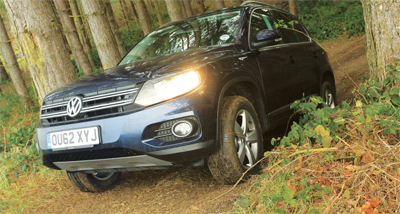 Our Escape model is the off-road version of the Tiguan and therefore comes in at a smidgeon over £2000 more than the standard model. Both are equipped with VW’s 4MOTION intelligent four-wheel drive that kicks in when the system detects poor traction. I have always been a bit sceptical about these so-called ‘intelligent’ systems as they are reactive, i.e., you need your wheels to experience a bit of a problem before the electronics suss it out and then react accordingly and switch power delivery to a more even split between the axles.
Our Escape model is the off-road version of the Tiguan and therefore comes in at a smidgeon over £2000 more than the standard model. Both are equipped with VW’s 4MOTION intelligent four-wheel drive that kicks in when the system detects poor traction. I have always been a bit sceptical about these so-called ‘intelligent’ systems as they are reactive, i.e., you need your wheels to experience a bit of a problem before the electronics suss it out and then react accordingly and switch power delivery to a more even split between the axles.
I prefer a vehicle that lets me lock into four-wheel drive when I say so; which is why I will always be a bit wary of the intelligent SUVs that are swamping our 4×4 market these days. Yes, regular readers know that I am an old fashioned gal who loves a nice big transfer lever that you thrust into four low and know damn well that it is locked in and off you go into the wilderness.

 Sue Loy
Sue Loy 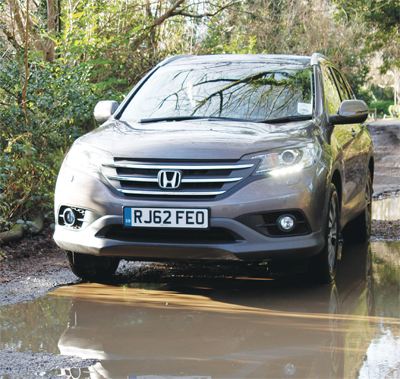 As a Toyota RAV4 owner, driving the CR-V was an interesting experience. The two models must be an ‘either/or’ for a lot of people looking for a family-sized SUV. I’m on my second RAV4 and will admit to being very happy with my choice, so being able to spend a week with the new fourth generation Honda CR-V was an opportunity not to miss.
As a Toyota RAV4 owner, driving the CR-V was an interesting experience. The two models must be an ‘either/or’ for a lot of people looking for a family-sized SUV. I’m on my second RAV4 and will admit to being very happy with my choice, so being able to spend a week with the new fourth generation Honda CR-V was an opportunity not to miss. Bob Cooke – contributor
Bob Cooke – contributor 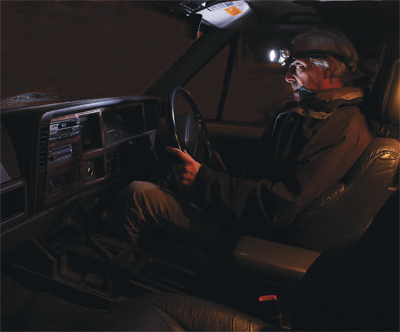 It’s just as well that I carry one of those head torch things in the Cherokee. Not just because we’ve entered the dark days of winter, though it’s useful on those odd occasions when you need to see if what you’ve just run over is edible. I don’t even need the torch to find my way up the driveway after parking because the Cherokee has a “sentinel” headlamp system, which leaves the lamps alight for about 45 seconds after switching off the ignition. I need the torch because the dashboard lamps have failed, so I need a means of checking my speed and finding the stereo and heater controls after dark. It’s an odd one – the dash illumination doesn’t work, nor does the stereo display, yet the digital clock still ticks away in the dark and the stereo still works, it just doesn’t show me what station I’m listening to. The handbook doesn’t assign a fuse to the dashboard illumination, so I’m somewhat bewildered.
It’s just as well that I carry one of those head torch things in the Cherokee. Not just because we’ve entered the dark days of winter, though it’s useful on those odd occasions when you need to see if what you’ve just run over is edible. I don’t even need the torch to find my way up the driveway after parking because the Cherokee has a “sentinel” headlamp system, which leaves the lamps alight for about 45 seconds after switching off the ignition. I need the torch because the dashboard lamps have failed, so I need a means of checking my speed and finding the stereo and heater controls after dark. It’s an odd one – the dash illumination doesn’t work, nor does the stereo display, yet the digital clock still ticks away in the dark and the stereo still works, it just doesn’t show me what station I’m listening to. The handbook doesn’t assign a fuse to the dashboard illumination, so I’m somewhat bewildered.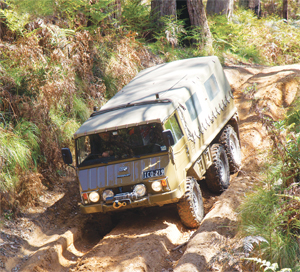 If four-wheel drive is good, then does that mean six is better? We take a trip in a recently restored Steyr-Puch Pinzgauer 6×6 to find out. Now this is a real man’s off-roader!
If four-wheel drive is good, then does that mean six is better? We take a trip in a recently restored Steyr-Puch Pinzgauer 6×6 to find out. Now this is a real man’s off-roader! Ian Seabrook
Ian Seabrook 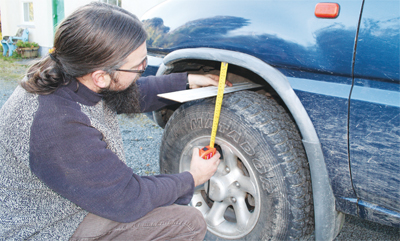 After repeatedly scraping the underside of my Maverick during a rock-strewn day of greenlaning, I decided it was time to check the ride height. The gap between the front tyre and wheelarch should be around 20mm less than the same gap at the rear. Use of a tape measure revealed that not only was the front end about 30mm low, it was another 10mm lower on the passenger side.
After repeatedly scraping the underside of my Maverick during a rock-strewn day of greenlaning, I decided it was time to check the ride height. The gap between the front tyre and wheelarch should be around 20mm less than the same gap at the rear. Use of a tape measure revealed that not only was the front end about 30mm low, it was another 10mm lower on the passenger side.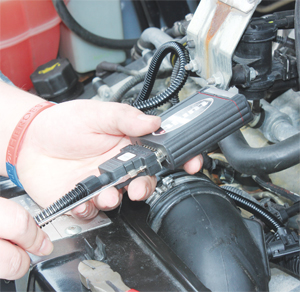 Comprehensive guide offering suggestions and advice on what you could do to improve the performance of your 4×4. Go on, indulge.
Comprehensive guide offering suggestions and advice on what you could do to improve the performance of your 4×4. Go on, indulge.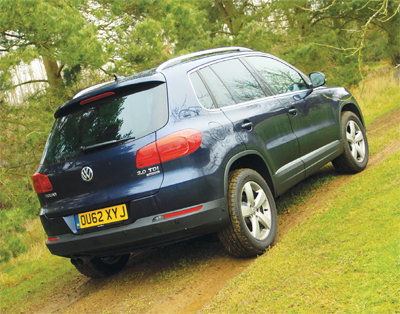 So last month we said farewell to our ES Tiguan and now it’s a big hello for the winter to our VW Escape, just in time for the wintry season.
So last month we said farewell to our ES Tiguan and now it’s a big hello for the winter to our VW Escape, just in time for the wintry season. Shion Scudamore – contributor
Shion Scudamore – contributor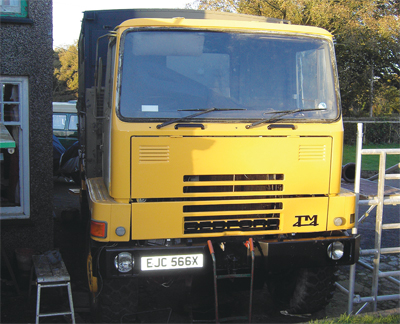 It’s been some time since I put pen to paper on the progress of the Bedford rebuild, as usual life filled up with “stuff” and other projects got in the way. By popular request from my family, I now find myself the owner of a Volkswagen T25 camper as well as the Bedford, although alas not a Syncro.
It’s been some time since I put pen to paper on the progress of the Bedford rebuild, as usual life filled up with “stuff” and other projects got in the way. By popular request from my family, I now find myself the owner of a Volkswagen T25 camper as well as the Bedford, although alas not a Syncro. Robert Pepper
Robert Pepper  Our Discovery 3’s odometer is now about to tick over 80,000 miles, many of which have been off-road, carrying a load or both. Lots of things wear out and need replacing over time – tyres and fluids of course, but also suspension. Sure, the Discovery has air suspension, which can be inflated so it doesn’t sag, but eventually everything wears out and for suspension in particular the dampers are a case in point. The Discovery was becoming rather too floaty over corrugations and bumps at cruise, and even at lower speeds the suspension bounced over rather than absorbed the undulations. So time for replacement dampers, but not a lot of choice. I spoke to Bilstein and found they have withdrawn their product from the Aussie market permanently, and then had a chat to Koni to discover that their product has also been withdrawn, albeit only temporarily. After a bit of research the best remaining option seemed to be the Land Rover standard kit, and as our Discovery is under warranty – thanks to a two-year extension programme – that was also the safe choice. So on went a set of shocks and, as ever with suspension changes, there’s quite a difference in handling, and that’s apparent even around town. There’s less pitch when accelerating, less nosedive when braking and more assured handling around the corners. And there’s better traction off-road, as all the sophisticated traction control in the world won’t help if the tyres aren’t well and truly in contact with the ground.
Our Discovery 3’s odometer is now about to tick over 80,000 miles, many of which have been off-road, carrying a load or both. Lots of things wear out and need replacing over time – tyres and fluids of course, but also suspension. Sure, the Discovery has air suspension, which can be inflated so it doesn’t sag, but eventually everything wears out and for suspension in particular the dampers are a case in point. The Discovery was becoming rather too floaty over corrugations and bumps at cruise, and even at lower speeds the suspension bounced over rather than absorbed the undulations. So time for replacement dampers, but not a lot of choice. I spoke to Bilstein and found they have withdrawn their product from the Aussie market permanently, and then had a chat to Koni to discover that their product has also been withdrawn, albeit only temporarily. After a bit of research the best remaining option seemed to be the Land Rover standard kit, and as our Discovery is under warranty – thanks to a two-year extension programme – that was also the safe choice. So on went a set of shocks and, as ever with suspension changes, there’s quite a difference in handling, and that’s apparent even around town. There’s less pitch when accelerating, less nosedive when braking and more assured handling around the corners. And there’s better traction off-road, as all the sophisticated traction control in the world won’t help if the tyres aren’t well and truly in contact with the ground.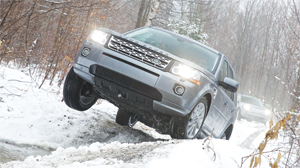 Land Rover’s Freelander had never been a 4×4 to excite the Editor’s interest. However, after a few days of freezing rain, heavy snow, ice roads and dropping temperatures, he’s ready to reconsider…
Land Rover’s Freelander had never been a 4×4 to excite the Editor’s interest. However, after a few days of freezing rain, heavy snow, ice roads and dropping temperatures, he’s ready to reconsider…